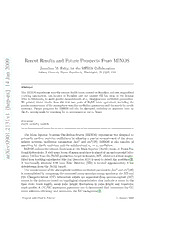
Recent Results and Future Prospects from MINOS PDF
Preview Recent Results and Future Prospects from MINOS
9 Recent Results and Future Prospects From MINOS 0 0 2 Jonathan M. Paley, for the MINOS Collaboration n Indiana UniversityPhysics Department, Bloomington, IN 47403, USA a J 4 1 Abstract ] x The MINOS experiment uses the intense NuMI beam created at Fermilab and two magnetized e tracking calorimeters, one located at Fermilab and one located 735 km away at the Soudan - Mine in Minnesota, to make precise measurements of ν disappearance oscillation parameters. p µ We present recent results from the first two years of NuMI beam operations, including the e h precisemeasurementoftheatmosphericneutrinooscillationparametersandthesearchforsterile [ neutrinos. Future prospects for MINOS will also be discussed, including an improved limit on theθ13 mixing angle by searching for νe appearance in theνµ beam. 1 v 1 Key words: 3 PACS: 14.60.Pq,14.60.St 1 2 . 1 The Main Injector Neutrino Oscillation Search (MINOS) experiment was designed to 0 9 primarily confirm neutrino oscillations by allowing a precise measurement of the atmo- 0 spheric neutrino oscillation parameters ∆m2 and sin2(2θ). MINOS is also capable of : searching for sterile neutrinos and the subdominant ν →ν oscillation. v µ e i MINOSutilizestheintenseNeutrinosattheMainInjector(NuMI)beamatFermiNa- X tionalLaboratory.Averypurebeamofmuonneutrinosisaimedatanundergroundlabo- r ratory735kmfromtheNuMIproductiontargetinSoudan,MN,wherea5.4ktonmagne- a tiziedirontrackingcalorimeter(the FarDetector,FD)isusedtodetecttheneutrinos[1]. A functionally identical 0.98 kton Near Detector (ND) is located approximately 1 km downstream from the NuMI target. Themeasurementoftheatmosphericneutrinooscillationparameters∆m2andsin2(2θ) isaccomplishedbycomparingthemeasuredmuonneutrinoenergyspectraintheNDand FD. Charged-current (CC) interaction events are separated from neutral-current (NC) events in the detectors based on topological characteristics that indicate a muon in the final state: track length, mean pulse height, fluctuation in pulse height and transverse track profile. A CC/NC separationparameter cut is determined that maximizes the CC event selection efficiency and minimizes the NC background[2]. PreprintsubmittedtoElsevier 14January2009 · 10-3 4.40 150 MINOS Far Detector 33..55 Far detector data vents / GeV100 NBNeoCs obt saoccsilkclagilltraiootuinonsnd fit -322)eV| (10m223...3550 E 50 D| 2.20 MINOS best oscillation fit MINOS 90% Super-K 90% 11..55 MINOS 68% Super-K L/E 90% MINOS 2006 90% K2K 90% 0 1.01 00 55 1100 1155 220033005500 0.6 0.7 0.8 0.9 1 Reconstructed neutrino energy (GeV) sin2(2q ) Fig. 1. Measured νµ energy spectrum in the MI- Fig. 2. 68% and 90% contour lines for the oscil- NOSFD(blackpoints),comparedtotheexpected lationfitparameters∆m2 andsin2(2θ)compared spectrumforthecaseofnooscillations. tootherexperimentalmeasurements. The energy spectrum for CC events is measured in the ND and extrapolated to the FD. The extrapolation method uses MC to determine energy smearing and acceptance correctionsfortheexpectedFDenergyspectrum.Thedominantsystematicuncertainties in the predicted FD spectrum are a 4% normalization uncertainty, a 10.3% hadronic energycalibrationuncertaintyanda50%uncertaintyontheNCbackgroundthatpassthe CCcutselectioncriteria.Thenormalizationandhadronicenergyuncertaintiesprimarily effectthemeasurementof∆m2 atthelevelof±0.081×10−3eV2 and±0.052×10−3eV2 respectively. The NC backgroundis the largest effect on the measurement of sin2(2θ) at the level of ±0.016. Fig. 1 shows the measured FD energy spectrum, the expected spectrum with no os- cillations, the best oscillation fit to the data, and the NC background (significant only in the lowest energy bin). A total of 848 events are observed in the FD, with 1065±60 events expected under the no-oscillation hypothesis for a data set based on 3.36×1020 protons on target (POT). Fitting the observed energy spectrum to the survival proba- bility, and constraining the fit parameters to their physically meaningful values, we find ∆m2 =2.43±0.13×10−3andsin2(2θ)>0.90(90%CL),withaχ2/ndof =90/97.Fig.2 showsthe oscillationparameterphase space allowedby the latestMINOS measurement, withcomparisonsto otherexperimentsandthe previousMINOSmeasurement.Alterna- tive hypotheses of neutrino decay[3] and neutrino decoherence[4] have also been tested withtheMINOSdata,andthesearedisfavoredwithrespecttotheosciallationhypothesis by 3.7σ and 5.7σ respectively. Since the NC event rate is independent of neutrino flavor, and thus unaffected by oscillations between the three active neutrino flavor states, a deficit in the NC rate in the FD would indicate the existence of at least one additional sterile neutrino (ν ). The s visible energy spectrum of NC (shower-like)events in the ND is extrapolated to the FD in search for such a deficit. Fig.3showsthemeasuredvisibleenergyspectrumintheFD,basedon2.46×1020POT, alongwiththeexpectedspectraforθ13=0andθ13 attheChoozlimit[5]andthepredicted 2 MINOS Projected 90% Exclusion Region 50 2 MINOS Preliminary: 2.46 · 1020 POT |D m2| = 2.4x10-3 eV2 eV 40 qF1a3r =D 0etector Data 1.5 sin2(322q23) = 1.0 G q = 0.21, d = 3p /2 vents/ 2300 CD1C3m 2B =a 2c.3k8g ·r o10u-3nedV2 pd) ( 1 33C..H2255OxxO11Z00 22900 0PP%OO TTC LDDmm323222 >< 00 ((22000088,, 1100%%)) E 10 sin2(2q 32) = 1 0.5 69..55xx11002200 PPOOTT DDmm323222 >> 00 ((++ ~~12 yyeeaarr,s 5, %5%)) 0 0 0 5 10 15 20 25 30 10-2 10-1 E (GeV) sin2(2q ) PPRREELLIIMMIINNAARRYY vis 13 Fig. 3. Visible energy spectrum for NC events in Fig. 4. MINOS sensitivity to sin2(2θ13) for vari- the FD compared to the dominant CC νµ back- ousdatasets.Thecurrentdatasetwillproducea ground and predicted spectra for θ13=0 and θ13 sensitivityroughlyequaltothecurrentbestlimit attheChoozlimit. (solidblackline). νµCCeventbackground.Thequantityfs =(Pνµ→νs)/(1−Pνµ→νµ)describesthefraction of ν that have oscillated to ν in a simple four-flavormodel where oscillations to sterile µ s neutrinos ocurr at the same mass splitting as the ν disappearance measured from the µ CC interactions. For the case of θ13=0, fs =0.28+−00..2258 (stat. + syst.) or fs <0.68 (90% CL). For the case of θ13 at the Chooz limit, fs = 0.43+−00..2237 (stat. + syst.) or fs < 0.80 (90% CL) [6]. An excess of ν events in the MINOS FD would indicate ν → ν oscillations and e µ e a non-zero value for the θ13 oscillation term. CC νe events in the MINOS detectors are taggedbysearchingforeventsthathaveelectromagneticshowerprofilesinthefinalstate. TheCCν eventsappearverysimilartoNCeventswhicharethe dominantbackground, e althoughlow-energyCCν eventsalsocontributesignificantlytothe backgroundinthis µ measurement. For a data set based on 3.25×1020 POT, approximately 12 CC ν events e are expected in the FD with 42 background events. Fig.4showstheMINOSsensitivitytosin2(2θ13)asafunctionoftheCPviolatingphase δ.With the currentdata setbeing analyzedbasedon3.25×1020 POT,the sensitivityof the MINOS measurement is roughly that of the current best limit; within about a year, we expect an improvement in the limit by about a factor of two based on a doubling of statistics and a reduction by 50% of the estimated backgrounds. We expect to present first results on the search for ν appearance in the MINOS detectors by spring of 2009. e References [1] D.G.Michael,et.al.,Nucl.Instr.andMeth.A596(2008) 190 [2] P.Adamson,et.al.,Phys.Rev.Lett. 101,131802(2008) [3] V.Barget,et.al.,Phys.Rev.Lett. 82,2640(1999) [4] G.L.Fogli,et.al.,Phys.Rev.D67,093006(2003) [5] M.Apollonio,et.al.,Eur.Phys.J.C27,331(2003) [6] P.Adamson,et.al.,Phys.Rev.Lett. 101,221804(2008) 3
